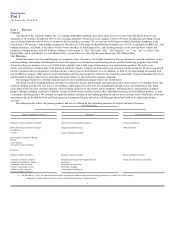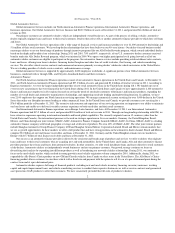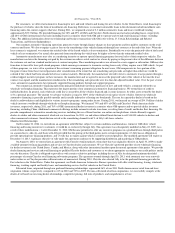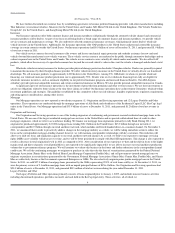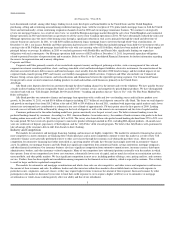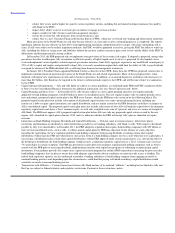Ally Bank 2011 Annual Report Download - page 8
Download and view the complete annual report
Please find page 8 of the 2011 Ally Bank annual report below. You can navigate through the pages in the report by either clicking on the pages listed below, or by using the keyword search tool below to find specific information within the annual report.
Table of Contents
Ally Financial Inc. • Form 10−K
have discontinued, include, among other things: lending to real estate developers and homebuilders in the United States and the United Kingdom;
purchasing, selling and securitizing nonconforming residential mortgage loans (with the exception of U.S. prime jumbo mortgage loans) in both the United
States and internationally; certain conforming origination channels closed in 2008 and our mortgage reinsurance business. We continue to strategically
review our mortgage business. As a result of our review, we exited the European mortgage market through the sale of our United Kingdom and continental
Europe operations in 2010 and entered into an agreement to sell the assets of our Canadian operations in 2011. We have substantially reduced the risk in our
Mortgage operations since the onset of the housing crisis through a significant reduction in total assets, primarily through the runoff and divestiture of
noncore businesses and assets. In 2011, we sold $250 million in domestic legacy mortgage loans to investors through whole−loan securitizations. At
December 31, 2011, our Legacy Portfolio and Other operations had total assets of $10.9 billion that included mortgage loans held−for−investment with a net
carrying value of $8.0 billion and mortgage loans held−for−sale with a net carrying value of $1.6 billion, which have been marked at 47% of their unpaid
principal balance on average. In addition, in 2010 we reached agreements with Freddie Mac and Fannie Mae, significantly limiting our repurchase
obligations with each counterparty. Our Mortgage operations hold reserves of $825 million at December 31, 2011, for potential repurchase obligations
related to potential breaches of representations and warranties. Refer to Note 31 to the Consolidated Financial Statements for further information regarding
the reserve for representation and warranty obligations.
Corporate and Other
Corporate and Other primarily consists of our centralized corporate treasury and deposit gathering activities, such as management of the cash and
corporate investment securities portfolios, short− and long−term debt, retail and brokered deposit liabilities, derivative instruments, the amortization of the
discount associated with new debt issuances and bond exchanges, most notably from the December 2008 bond exchange, and the residual impacts of our
corporate funds−transfer pricing (FTP) and treasury asset liability management (ALM) activities. Corporate and Other also includes our Commercial
Finance Group, certain equity investments, and reclassifications and eliminations between the reportable operating segments. Our Commercial Finance
Group provides senior secured commercial−lending products to small and medium sized businesses primarily in the United States.
Ally Bank
Ally Bank raises deposits directly from customers through the direct banking channel via the internet and over the telephone. We have quickly become
a leader in direct banking with our recognizable brand, accessible 24/7 customer service, and competitively priced deposit products. We have distinguished
our direct bank with our “Talk Straight, Do Right, Be Obviously Better.” branding and products that are “Easy to Use” with “No Fine Print, Hidden Fees,
Rules or Penalties.”
Ally Bank provides our automotive finance and mortgage loan operations with a stable and low−cost funding source and facilitates prudent asset
growth. At December 31, 2011, we had $39.6 billion of deposits including $27.7 billion of retail deposits sourced by Ally Bank. The focus on retail deposits
and growth in our deposit base from $19.2 billion at the end of 2008 to $39.6 billion at the end 2011, combined with improving capital markets and a lower
interest rate environment have contributed to a reduction in our cost of funds of approximately 178 basis points since the first quarter of 2009. Looking
forward, our cost of funds will be influenced by changes in the level of deposits as well as the interest rate environment and the state of capital markets.
Consumer preferences for the online banking model have grown consistently over the past several years. We believe internet banking is now the
preferred banking channel by consumers. According to a 2011 American Bankers Association survey, the number of bank customers who prefer to do their
banking online increased to 62% in 2011 from just 36% in 2010. The survey also showed those who prefer branch banking declined from 25% to 20% over
the same period. We have received a positive response to innovative product offerings launched in 2011, including IRA deposit products, 48−month raise
your rate certificates of deposit, pop money, eCheck deposit, and the “Ally Perks” debit rewards program. We believe that Ally Bank is well−positioned to
take advantage of the consumer−driven shift from branch to direct banking.
Industry and Competition
The markets for automotive and mortgage financing, banking, and insurance are highly competitive. The market for automotive financing has grown
more competitive as more consumers are financing their vehicle purchases and as more competitors continue to enter this market as a result of how well
automotive finance assets generally performed relative to other asset classes through the economic cycle during the past three years. More recently,
competition for automotive financing has further intensified as a growing number of banks have become increasingly interested in automotive−finance
assets. In addition, our mortgage business and Ally Bank face significant competition from commercial banks, savings institutions, mortgage companies,
and other financial institutions. Our insurance business also faces significant competition from automotive manufacturers, insurance carriers, third−party
administrators, brokers, and other insurance−related companies. Many of our competitors have substantial positions nationally or in the markets in which
they operate. Some of our competitors have lower cost structures, substantially lower costs of capital, and are much less reliant on securitization activities,
unsecured debt, and other public markets. We face significant competition in most areas, including product offerings, rates, pricing and fees, and customer
service. Further, there has been significant consolidation among companies in the financial services industry, which is expected to continue. This is likely
to result in larger and better capitalized competitors.
The markets for automotive and mortgage securitizations and whole−loan sales are also competitive, and other issuers and originators could increase
the amount of their issuances and sales. In addition, lenders and other investors within those markets often establish limits on their credit exposure to
particular issuers, originators, and asset classes, or they may require higher returns to increase the amount of their exposure. Increased issuance by other
participants in the market or decisions by investors to limit their credit exposure to (or to require a higher yield for) us or to automotive or mortgage
securitizations or whole−loans could negatively affect our ability and that of our subsidiaries
5




